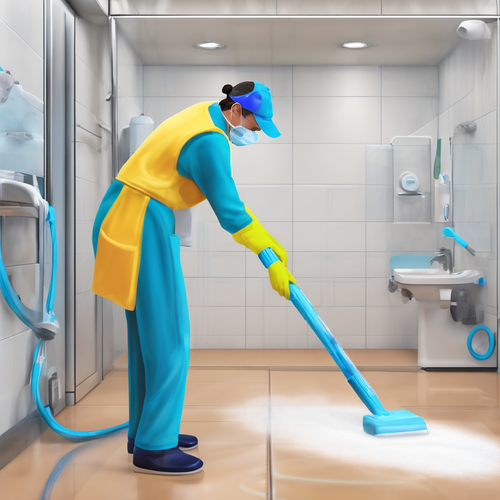Cleaning Protocols in the Age of Pandemics: Protecting Public Health One Sweep at a Time
Ah, cleaning protocols – the unsung heroes of our times. In an era defined by global health crises, cleaning has morphed from a mundane chore into a first line of defense against invisible foes. One might say the mop is the new sword, and the bucket is the shield against the viruses lying in wait. Yet, here we are, armed not with Lysol, but with lifestyles impacted by sweeping changes. Or perhaps, more appropriately, cleaning changes. 🧽
The Shift in Cleaning Paradigms: From Routine to Regimen
Cleaning practices in our homes, offices, and public spaces have historically revolved around the age-old adage: “A clean space is a happy space.” But as the world faced the wrath of pandemics, this slogan was unceremoniously turned on its head. What was once a matter of aesthetics has escalated to a moral obligation—an act of love or, some might argue, self-preservation. 🦠
In 2020, during the COVID-19 pandemic, health officials emphasized cleaning protocols that many had never considered. Enhanced routines emerged, akin to the Spring cleaning ritual on steroids, with disinfectants taking on the role of valiant protectors. A study from the American Journal of Infection Control highlights that effective cleaning combined with disinfection reduces the risk of virus transmission by up to 80%. As our understanding of pathogens deepens, so too do our expectations for hygiene. ✨
Key Protocols That Changed the Game
So, what does this new cleaning regimen entail? It’s not just about tidying your space after a raucous dinner party anymore. Here are core elements that define the protocols implemented globally during health emergencies:
- Frequent High-Touch Surfaces Cleaning: It turns out, our perpetual affection for door handles, light switches, and handrails makes them the perfect breeding ground for germs. These surfaces require disinfecting several times a day, weaving them into the fabric of a deeper, cleaner tapestry.
- Use of Approved Disinfectants: You wouldn’t wash your car with a bottle of soda, so why would you use just any old cleaner on high-risk surfaces? Proven disinfectants that meet EPA guidelines are essential here. Brands project a cleanliness akin to that of a sterile operating room. 🧴
- Personal Protective Equipment (PPE): Wearing gloves, masks, and even eye protection during cleaning has become standard. Like knights donned in armor, cleanliness warriors gear up before entering the battlefield of germs.
- Guidelines by Health Authorities: Adhering to guidelines from the CDC or WHO is imperative. Think of these recommendations as the rulebook for your new cleaning league, akin to being given a map through a perilous minefield.
An Irony of Overkill: The Discomfort of Over-Cleanliness
And herein lies a conundrum: while the push for rigorous cleaning settings aims to foster safety, such protocols have sparked an ironic evolution. Although a clean surface is the goal, the act of sanitizing itself has evolved into an obsession bordering on the neurotic. While sanitization can save us, it can also reveal our vulnerabilities as we scramble to clean our way to security. Perhaps we’re cleaning ourselves away from reality! 🧼
Workplace Dynamics and Public Spaces: Beyond the Domestic
Public spaces have been similarly revolutionized. The workplace has transformed into a sanitization chamber that rivals a science lab. Employees often find themselves navigating a land of hand sanitizer stations, spaced-out desks, and visibly marked paths to minimize contact. Yet this striking antithesis reveals how times have changed. What was once a bustling social scene—a joyous cacophony of voices—has been replaced by a sterile silence that is both eerie and necessary. 🏢
Post-Pandemic Considerations: Moving Forward Together
As we step out of one of the most significant health crises in modern history, where does that leave us? Will we embrace cleaning habits like diligent guardians? Or will we soon find ourselves slack once again—drawn back into our careless ways by the siren call of comfort? It’s a bit like wondering if our penchant for avocado toast will ever rival that of a simple fried egg. 🥑
Cleaning protocols during pandemics have not only reshaped environments but have also successfully heightened our collective awareness. The responsibility now rests in our hands to ensure such protocols endure beyond the shadows of urgency. As we embrace a world where cleanliness becomes second nature, let us carry forward these lessons, not as burdens, but as badges of our resilience in the face of adversity. 🏅
“Sanitation is more than a responsibility; it’s an act of solidarity,” says Dr. Maya Chen, a leading epidemiologist. “When we clean, we protect, not only ourselves but also those around us.”
In the end, as we emerge from our cleaning cocoon, let’s redefine the narrative surrounding cleanliness. It’s not merely about eliminating germs—it’s about fostering environments of safety and well-being. The motto of our future: Cleanliness is akin to a shield protecting the vulnerable, our families, and ultimately, ourselves.
